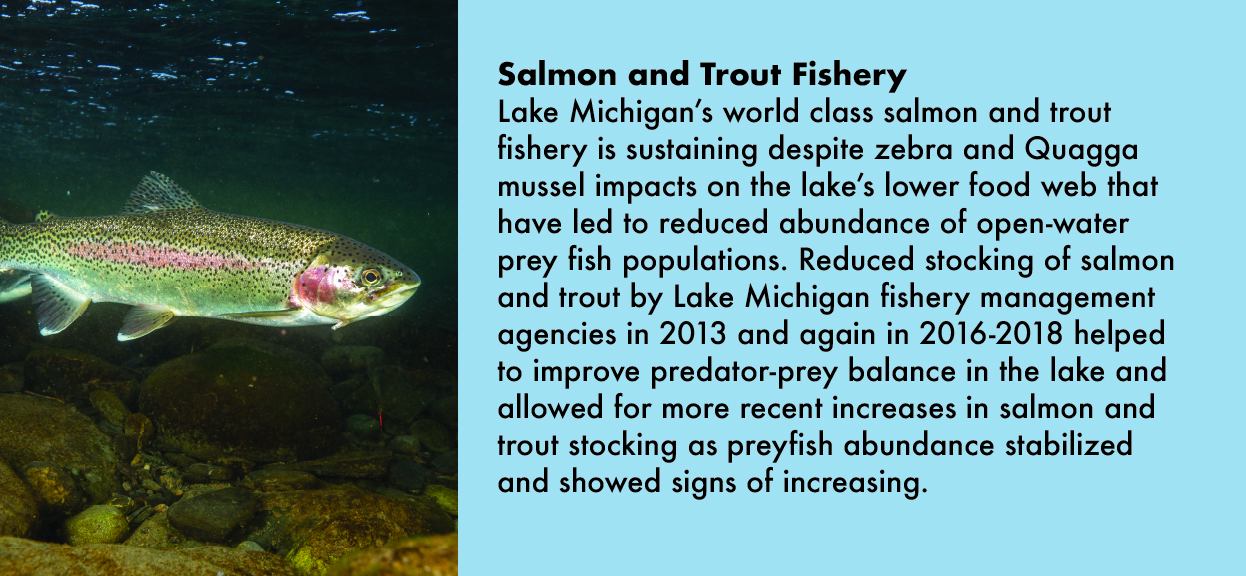
Photo by Blake Bushman.



Photo by Blake Bushman.
Managing the fisheries resources in Illinois has been ongoing for 200 years.
“Legislative actions regarding the Illinois fishery predates the declaration of Illinois Statehood on December 8, 1818, with passage of the 1817 legislative measure to provide for the damming of the Kaskaskia River to construct a ‘fishery,’” explained Mike McClelland, Chief of the Illinois Department of Natural Resources’ Division of Fisheries. “The first act for the preservation of fish—forbidding the obstruction of streams by dams, nets, seines or wires—was enacted by the General Assembly in 1871. More than two decades later, in 1897, a three-person state board of game commissioners was created and charged with the establishment of fish hatcheries and the appointment of a competent superintendent of the hatcheries who would ‘take all necessary measure for the propagation of native food fishes.’”
Over the past 150-plus years, the Illinois Game and Fish Commission was replaced by the Illinois Department of Conservation and then reorganized into the current Illinois Department of Natural Resources (IDNR) in 1995. Over time, research has improved the knowledge of our aquatic resources, legislative protections have been increased and programs have been created to benefit landowners and commercial and recreational anglers. Today, staff of the IDNR Division of Fisheries work to conserve and enhance the state’s fisheries and aquatic life resources.
The role of the Division of Fisheries is broad. Staff implement programs and policies to monitor management of fish populations for the protection and restoration of their habitats. Measures are implemented to prevent, manage and control aquatic nuisance species. Diverse recreational fishing opportunities are created. IDNR fish hatcheries produce 18 to 22 species of fish annually for stocking into the waters of the State. Commercial fishing is utilized as a fisheries management strategy. Fish, aquatic resources, anglers and commercial harvest are monitored, assessed and regulated. Educational programs and fishing clinics are conducted. Staff network with state sites, other units of local governments and conservation groups on a variety of issues.
“Illinois is a water-rich state, bordered by 800 miles of rivers and Lake Michigan,” McClelland noted. “Within our borders are more than 87,000 miles of rivers and streams, three reservoirs totalling 54,580 acres and more than 91,800 public, private and commercial impoundments. Utilizing many of these waters annually are nearly 1.2 million anglers (licensed, under 16 and private pond owners) as well as 40,000 non-resident anglers.”
A current staff of 78 conduct programs funded under the Fish and Wildlife Fund and the Fish Management Fund ($16 million annually) and federal funding opportunities for managing aquatic nuisance species ($6 million annually). Funding for these staff comes from Illinois fishing license sales and federal grants from the U.S. Fish and Wildlife Service (USFWS) Sport Fish Restoration and nuisance species programs as well as the U. S. Environmental Protection Agency Great Lakes Restoration Initiative through the USFWS. Fisheries staff also work on State Wildlife Grants for at-risk species throughout the state. While some of the funding, such as nuisance species efforts, are identified in federal and congressional legislative initiatives, Sportfish Restoration (Dingle-Johnson) funding directly and significantly contributes to IDNR Fisheries. The Sportfish Restoration Act (SFRA; or Dingle-Johnson Act) was passed by Congress in 1950. This Act is funded by sportsmen and women through excise taxes on fishing equipment, import duties, boats and a portion of the gasoline fuel tax identified from small boat motors. Illinois license dollars are then leveraged with federal SFRA to mange and improve Illinois Sportfish management. In 2022, Illinois’ portion of these funds based on license sales accounted for nearly $7 million.
“Scores of successes have been achieved in the more than 150 years fisheries staff have worked to conserve and enhance Illinois’ aquatic resources (see below),” McClelland said. “I am proud of the Division of Fisheries staff who remain relentless in their work to maintain a healthy and viable fishery and further expand angler opportunities.”
The IDNR Division of Fisheries is honored to be the newest OutdoorIllinois Journal partner and welcomes the opportunity communicate, and converse with, readers about fishing in the Prairie State.











Kathy Andrews Wright retired from the Illinois Department of Natural Resources where she was editor of OutdoorIllinois magazine. She is currently the editor of OutdoorIllinois Journal.
Submit a question for the author
Question: In my community, there is a 26.9 acre piece of land for sale. It is on the Carina Lake Forest Preserve and the Des Plaines River Trail and Greenway. https://www.lcfpd.org/lake-carina/ If you click on the map link below (it takes a few seconds to load completely) you will see a map with main roads that form a triangle around the forest preserve. The land for sale is the white parallelogram in the lower left hand corner. https://maps.lakecountyil.gov/trailmap/?&extent=-9789587.2215%2C5212808.8976%2C-9788111.0314%2C5215192.7774%2C102100 Would you know if this land could possibly sustain a fishery? Any information is welcome concerning such an effort.
Thank you!